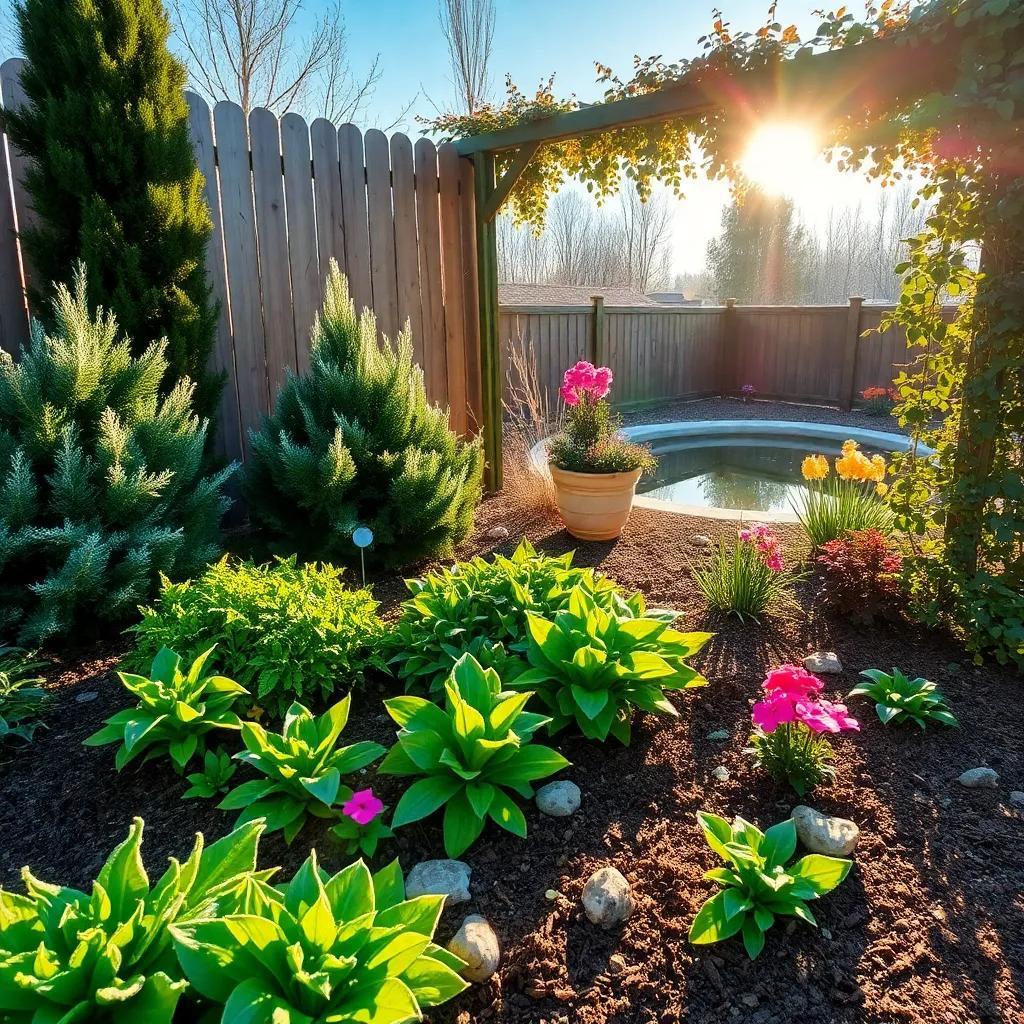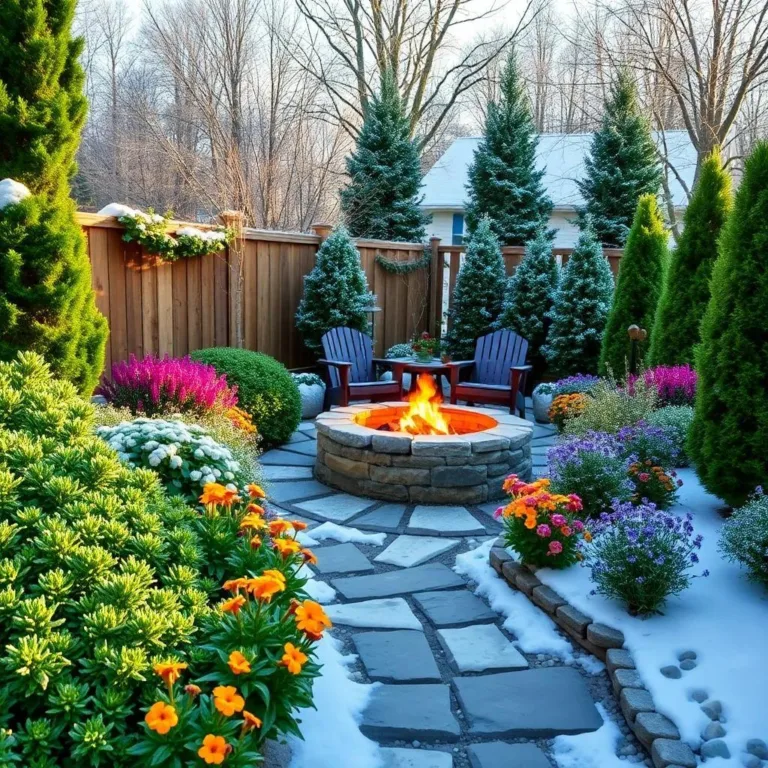Creating a winter garden that shines with warmth and life is easier than you might think! With a few clever techniques, you can turn your outdoor space into a cozy retreat, even when the temperatures drop. Let’s explore how to craft microclimates, maximize sunlight, and add some fire and wind protection to keep your plants happy and thriving all season long!
Creating Microclimates for Winter Gardening
Creating cozy microclimates in your winter garden can really help your plants thrive, even when the temperatures dip! Imagine having little pockets of warmth and shelter that allow your favorite plants to flourish. This is all about strategically using the elements around you, and it’s easier than you might think!
Here are some simple ways to create those perfect microclimates:
- Use Fences and Hedges: Planting or installing fences and hedges can shield your garden from harsh winter winds. They act like big, friendly barriers! Not only do they keep your plants safer, but they also help create warmer areas by blocking those chilly gusts.
- Reflective Surfaces: Want to bounce some sunshine around? Use reflective materials! Think about placing mirrors or light-colored stones in sunny spots. These shiny additions can help direct sunlight onto your plants, which is especially helpful if some are hiding in the shade.
- Mulch: This is a gardener’s best friend! A cozy layer of organic mulch around your plants can keep the soil warmer and protect the roots. It also prevents those annoying temperature swings that can hurt tender plants.
- Taller Plants for Shade: If you have some taller plants, consider planting them on the northern or western side of your garden. They can provide some shade for smaller, sun-sensitive plants without blocking the sun’s rays too much.
- Water Features: Here’s a fun one! Adding a pond or fountain can actually help regulate temperature. Water absorbs heat during the day and releases it slowly, creating a pleasant area for both plants and relaxation!
Creating microclimates is all about using what you have to protect and encourage your garden to thrive in winter. It’s like giving your plants a warm hug when the weather gets cold!
Maximizing Solar Exposure for Plant Health
Getting your garden to soak up sunlight is key to keeping it lively during winter! Plants, just like us, need their dose of sunshine to stay happy and healthy. Here are some friendly tips on how to make the most of the sun’s rays:
- Know the Sun’s Path: First, observe where the sun travels in your garden throughout the day. Sun-loving plants should be placed where they get the most direct sunlight. That sunny south-facing spot? Perfect for your little buddies!
- Plant Arrangement: When planting, think vertically! Taller plants should go in the back and shorter ones in the front. This way, the big guys won’t block the light from reaching the smaller plants. It’s like giving everyone a fair chance to shine!
- Pruning is Key: Trim any branches or foliage that are getting a bit too friendly and blocking the sun. Regular pruning lets that glorious light penetrate deeper into your garden, benefiting all your plants.
- Utilize Reflective Surfaces: If you have shaded areas, why not add some reflective elements? Mirrors, light-colored stones, or walls can brighten up those darker spots. It’s like giving them a sunny boost!
- Vertical Space: Don’t forget about the vertical space! Use trellises or pergolas to train climbing plants. This creates an eye-catching display while maximizing sunlight for everything below.
By maximizing solar exposure, your winter garden will be a warm haven for your plants! With a little planning, you can help them thrive while enjoying the warm glow of the sun! Who doesn’t want a garden that’s full of life, even in the winter months? 🌞

Utilizing Passive Solar Design Techniques
When it comes to passive solar design, I think of it as using the sun’s natural energy to make my garden feel warm and cozy! This approach focuses on how we can design our spaces to capture and use sunlight effectively. It’s an eco-friendly way to support our plants, especially in those chilly winter months. Here are a few techniques I’ve found helpful:
- South-Facing Orientation: Positioning garden beds, seating areas, and other features to face south is a fantastic way to catch sunlight. South-facing spots get the most direct sunlight during winter, which means more warmth for your plants and for me when I’m enjoying my garden!
- Thermal Mass Materials: Using materials like stone or concrete can be a game changer. These materials absorb heat during sunny days and slowly release it when temperatures drop. Imagine walking on a warm stone path in the middle of winter—it feels nice, doesn’t it? Consider adding stone walls or paths to your garden layout to help with this!
- Good Insulation: If you’re building any structures, like a greenhouse, keep insulation in mind. Using double-glazed windows or insulated materials can keep the heat in and the chilly air out. This helps create a warm haven for your winter plants!
- Ventilation: Want to avoid overheating when it gets warm? Design your structures with proper ventilation! Opening windows or vents allow fresh air to flow, keeping temperatures comfortable for both plants and me.
By utilizing these passive solar design techniques, I can create a thriving winter garden full of life and warmth! Not only does it benefit my plants, but it also makes my outdoor space a delightful area to relax and enjoy.
Incorporating Fire Features for Warmth
What’s better than sitting outdoors in winter with a warm fire crackling away? Fire features not only add warmth but also create a lovely gathering spot in your garden! Here are some of my favorite fire elements that bring both heat and ambiance to my outdoor space:
- Fire Pits: A classic favorite! Whether you choose a wood-burning fire pit or a gas-powered one, this feature becomes the heart of your winter garden. I love gathering friends around the fire, roasting marshmallows, and sharing stories as the flames dance away!
- Outdoor Fireplaces: For something a little fancier, consider an outdoor fireplace. These can be custom-built to match my garden style and act as a stunning focal point. They not only provide heat but also become an architectural piece that draws people in.
- Torches and Fire Bowls: If my space is smaller, I use torches or fire bowls. These portable wonders can be arranged around seating areas, providing warmth and creating an enchanting atmosphere. Plus, they are easy to move around when I want to change things up!
- Safety First: When setting up fire features, safety is key. I always make sure to keep a safe distance from flammable materials and have a fire extinguisher nearby, just in case!
With these fire features, winter evenings can feel so much cozier! They light up my garden and create a welcoming environment, encouraging me to spend more time outside, even when it’s chilly.
Implementing Effective Windbreaks in Your Garden
Windbreaks are my secret weapon when it comes to protecting my garden from harsh winter winds! These barriers can transform my outdoor space into a cozy paradise, creating a microclimate that’s warm and inviting. Here’s how I like to incorporate effective windbreaks:
- Solid Fences: A sturdy fence, whether wooden or vinyl, is perfect for blocking those nasty gusts. I make sure it’s tall enough to deflect the wind over my garden. Plus, it adds a nice boundary to my space!
- Hedges: Planting dense shrubs or trees can provide a natural windbreak. Evergreens are my go-to choice because they hold their leaves all year round. Not only do they block wind, but they also add beautiful greenery to my winter landscape!
- Living Windbreaks: Want to be a bit more creative? Consider using a variety of trees and shrubs to create a living windbreak! This not only helps block the wind but also attracts birds and other wildlife, making my garden feel lively.
- Strategic Placement: When planning my windbreaks, I always keep an eye on the prevailing winds in my area. By placing my windbreaks where the wind hits hardest, I can better protect my plants and create a more comfortable environment for myself.
By implementing these effective windbreaks, I can keep my garden cozy and sheltered! It’s amazing how a few thoughtful additions can make such a big difference in the overall health and happiness of my outdoor space!

